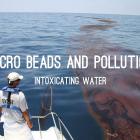You are here
» » The Link Between Microbeads and Climate...
The Link Between Microbeads and Climate Change
Microbeads beads have been making headlines recently as many countries around the world enact legislation to reduce their consumption or ban them entirely. As the name suggests, microbeads are tiny spheres of plastic that range in size from 10 micrometers to 1 millimeter. They are found in many personal care products like soaps, cosmetics, and toothpastes, and they are commonly used as exfoliants.
The problem with microbeads is that they are a major source of water pollution. The microbeads used in personal care products are designed to wash straight down the drain. However, plastic is not naturally biodegradable, and microbeads are too small to be caught by the filters used in water treatment plants. So despite their tiny size, microbeads are wreaking havoc on marine ecosystems because of the sheer quantity in which they are consumed. New York alone washes 19 tons of microbeads down the drain each year. They pollute waterways, become ingested by marine life, spread toxins through the foodchain, and can even be found in seafood consumed by humans [1].
Read more

